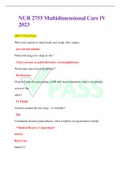Samenvatting
Laboratory animal science: Full summary
- Instelling
- Universiteit Leiden (UL)
All lectures in the course 'laboratory animal science' provided by the LUMC. information is outlined about animal models, housing lab animals, genetics and legislation.
[Meer zien]













